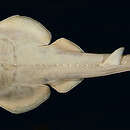en
names in breadcrumbs


The clubnose guitarfish (Glaucostegus thouin) is a critically endangered species of ray in the Glaucostegidae family. It is found from shallow coastal waters to a depth of 60 m (200 ft) in the Indo-Pacific, ranging from India to Southeast Asia, and also in the Red Sea.[1][3] There are also old unconfirmed records from the Mediterranean and Suriname.[1][4]
It reaches up to 3 m (9.8 ft) in length, but typically is less than 2.5 m (8.2 ft).It is pale yellowish or brownish with a pale snout. It has an unusual club-like tip of the snout, which separates it from other members of the genus Glaucostegus.[3]
The clubnose guitarfish (Glaucostegus thouin) is a critically endangered species of ray in the Glaucostegidae family. It is found from shallow coastal waters to a depth of 60 m (200 ft) in the Indo-Pacific, ranging from India to Southeast Asia, and also in the Red Sea. There are also old unconfirmed records from the Mediterranean and Suriname.
It reaches up to 3 m (9.8 ft) in length, but typically is less than 2.5 m (8.2 ft).It is pale yellowish or brownish with a pale snout. It has an unusual club-like tip of the snout, which separates it from other members of the genus Glaucostegus.